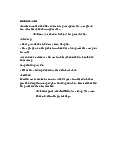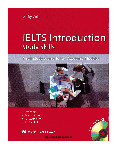





Preview text:
Multiple Choice Quiz (See related pages) 1
The difference between a planned result and the actual outcome is called a(an): flexible budget. A) operating budget. B) variance. C) financial budget. D) none of the above. E) 2
The Miles Corporation's budgeted revenues and expenses for last period were $400,000 and $250,000, respectively. The
actual results were: revenues, $420,000; expenses, $280,000. The company's profit variance (ignore income tax effects) was: $10,000 unfavorable A) $10,000 favorable B) $20,000 unfavorable C) $20,000 favorable D) None of the above E) 3
A budget that indicates revenues, costs, and profits for different levels of activity is called a: static budget. A) master budget. B) production budget. C) flexible budget. D) none of the above. E) 4
Use the following information to answer questions 4 and 5:
Smith Company's budgeted sales quantity was 80,000 units of product. The company's accountant, using regression
analysis, used the following cost formula to estimate costs at the master budget level for this year: Total cost = $500,000
+ ($5.20 x units produced and sold). The product had a budgeted selling price of $15.20 each. During the year, the actual
sales were 82,000 units and selling price was $15.15 per unit. The actual variable costs were $418,200 and the fixed costs were $500,000. Smith's profit variance was: $24,100 favorable A) $24,100 unfavorable B) $26,300 favorable C) $26,300 unfavorable D) None of the above E) 5
Smith's sales price variance was: $4,100 favorable A) $4,100 unfavorable B) $6,300 favorable C) $6,300 unfavorable D) None of the above E) 6
A form providing standard quantities of inputs used to produce a unit of output and the standard prices for the inputs is called a(an): job cost sheet. A) cost of production report. B) standard cost sheet. C) variance report. D) none of the above. E) 7
The difference between the flexible budget for inputs such as direct materials and direct labor and the actual results is the: price variance. A) efficiency variance. B) total quantity variance. C) total cost variance. D) none of the above. E) 8
Use the following information to answer questions 8 – 11:
Britton Corporation's standard cost sheet for variable costs is given below:
Direct material: 2 pounds at $1.20 per pound
Direct labor: 5.5 hours at $7.50 per hour
Last period, Britton purchased and used 30,000 lbs of material and 85,000 hours to produce 15,500 units of its only
product, Snuff. The actual material and labor costs were $37,500 and $642,500, respectively.
The direct material price variance was: $1,200 favorable A) $1,200 unfavorable B) $1,500 favorable C) $1,500 unfavorable D) None of the above E) 9
The direct material efficiency variance was $1,200 favorable A) $1,200 unfavorable B) $1,500 favorable C) $1,500 unfavorable D) None of the above E) 10
The direct labor price variance was: $5,000 favorable A) $5,000 unfavorable B) $1,875 favorable C) $1,875 unfavorable D) None of the above E) 11
The direct labor efficiency variance was: $5,000 favorable A) $5,000 unfavorable B) $1,875 favorable C) $1,875 unfavorable D) None of the above E) 12
Use the following information to answer questions 12 – 17:
The manager of Laura's Lamps needed information regarding the company's overhead. She felt that there was a problem
and asked Laura's accountant to give her a breakdown of the variable and fixed overhead variances. The company
experienced the following last period:
The company produced 50,000 lamps and incurred the following overhead costs: variable overhead, $88,000; fixed overhead, $67,000.
Overhead rates were based on direct labor hours. The budgeted DL hours were 40,000 hours and the budgeted
overhead was: variable, $80,000; fixed, $60,000. The standard hours allowed for each unit produce is 0.85 hours.
The amount of actual direct labor hours was 42,000 hours.
The variable overhead standard rate per direct labor hour was: $1.00 A) $1.50 B) $2.00 C) $2.50 D) None of the above E) 13
The variable overhead price variance was: $1,000 F A) $1,000 U B) $4,000 F C) $4,000 U D) None of the above E) 14
The variable overhead efficiency variance was: $1,000 F A) $1,000 U B) $4,000 F C) $4,000 U D) None of the above E) 15
The fixed overhead standard price per direct labor hour is: $1.25 A) $1.45 B) $1.50 C) $1.65 D) None of the above E) 16
The fixed overhead price variance was: $3,975 favorable A) $3,875 unfavorable B) $7,000 favorable C) $7,000 unfavorable D) None of the above E) 17
The fixed overhead production volume variance was: $3,750 favorable A) $3,875 unfavorable B) $7,000 favorable C) $7,000 unfavorable D) None of the above E) 18
If variance analysis indicated an unfavorable materials price variance, the journal entry to record this variance would include: a debit to materials. A) a credit to work-in-process. B)
a credit to materials price variance. C)
a debit to materials price variance. D) none of the above. E) 19
Last period the following results occurred in a standard costing system: total material variance, $2,000 unfavorable;
material efficiency variance, $1,500 favorable; and the actual price paid per pound for the material, $0.50 more than the
standard price per pound. The number of pounds of material purchased and used during the period was: 5,500 A) 6,000 B) 7,000 C) 7,500 D) None of the above E) 20
Use the following information to answer questions 20 – 23: ,p />Atlas Corporation's standard cost sheet is as follows: Direct material 4 feet at $5.00 per foot Direct labor 3 hours at $10.00 per hour Variable overhead 3 hours at $2.00 per hour Fixed overhead 3 hours at $1.00 per hour Additional information:
Actual results: purchased 30,000 lbs of material at $5.25 per lb (there were no beginning or ending material
inventories); direct labor cost incurred was 26,000 hours at $9.75 per hour; actual variable overhead incurred,
$50,000; actual fixed overhead incurred $43,000.
Overhead is applied to work-in-process on the basis of direct labor hours.
The company produced 8,000 units of product during the period.
The number of estimated hours for computing the fixed overhead application rate totaled 45,000 hours.
The material price and efficiency variances are: $7,500 F; $10,000 F A) $7,500 U; $10,000 F B) $6,200 F; $8,000 U C) $6,200 F; $8,000 U D) None of the above E) 21
The labor price and efficiency variances are: $6,500 F; $20,000 U A) $6,500 U; $20,000 U B) $7,200 F; $8,400 U C) $7,200 F; $8,400 U D) None of the above E) 22
The variable overhead price and efficiency variances are: $5,600 F; $4,200 U A) $5,600 U; $4,200 F B) $2,000 F; $4,000 U C) $2,000 U; $4,000 F D) None of the above E) 23
The fixed overhead price and production volume variances are: $2,000 F; $23,000 U A) $2,000 U; $23,000 F B) $4,000 F; $25,000 F C) $4,000 F; $25,000 U D) None of the above E)




